First aid saves lives. When it comes to first aid emergencies, though, just 5% of adults (1 in 20) know what to do!
Most first responders (the first person on the scene) won't be medically trained, but their assistance can still be vital for the casualty. In this article, we cover some of the most useful first aid acronyms to learn that will make the world of difference in a first aid emergency.
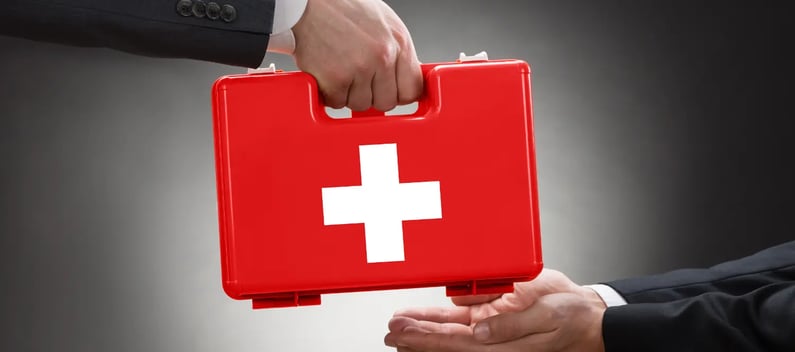
Medical emergencies can happen anywhere. Appropriate first aid training and equipment saves time and lives.
What is First Aid?
Whether you’re trying to stop a bleed or save a life, first aid is an urgent matter and refers to the immediate care carried out by the first responder or first aider to help a casualty. Effective first aid not only buys the casualty time before the emergency services or further backup arrives, but it also preserves life, prevents deterioration and promotes recovery - the 3 P's.
Having the knowledge and confidence to perform first aid really can be the difference between life and death. The first aid acronyms in this article were created to be easily remembered in an emergency situation and highlight some of the fundamentals covered in first aid training.
What is the most important consideration when providing first aid?
As a first aider, it's essential that you consider not only the casualty's safety but your safety as well. Checking for danger (covered in DR ABC) will help you identify what threats there are to your health and the casualty's health. Wearing the appropriate Personal Protective Equipment (PPE) can also prevent infection from spreading between you and the casualty.
|
Tip: If you work in an office, a school, a healthcare setting or anywhere else that might require first aid to be performed on site, you might choose to put up posters of the first aid acronyms in this article so that staff, including your appointed first aider, can remind themselves of what to do if they are required to carry out first aid. |
First Aid Acronyms
3 P's of First Aid
What are the responsibilities of a first aider?
The acronym PPP sets out the key responsibilities of a certified first aider: Preserve Life, Prevent Deterioration, and Promote Recovery. Similar to a primary survey, aka DR ABC(D), as explained in the next section, the 3 P's cover the immediate actions when a first responder is presented with a medical emergency.
Preserve Life
The role of a first responder is, first and foremost, to preserve the life of the casualty. Having checked for danger to yourself and the casualty, you should check the following 3 things:
- Airway
- Breathing
- Circulation
If the casualty is not breathing, you will need to perform CPR and/or defibrillation. Calling 999 immediately, especially if the casualty's condition is life-threatening, is crucial.
Prevent Deterioration
Once you have preserved the casualty's life, you need to prevent their condition from worsening. Keep them in a stable condition by putting the casualty in a comfortable position whilst waiting for the emergency services to arrive.
Depending on the medical emergency, stabilising the casualty's condition may also include:
- Stop bleeding by elevating the bleed above heart level before using a compression bandage or plaster to cover the area (see the acronym RICE for more information)
- Maintain close attention to the casualty if, for instance, they have had a seizure
- Provide sugary food or drink if they have had a diabetic episode to raise their blood sugar level
Promote Recovery
After performing first aid, the final stage of treatment from the first aider is to promote recovery. Do this by helping to relieve any pain and make sure they are comfortable, which includes calming them down.
DR ABC(D)
What does DR ABC stand for in first aid?
The acronym 'DR ABC' is used to help a first responder quickly assess an emergency health situation and guide them through the relevant steps. This is also known as a primary survey. DR ABC stands for Danger, Response, Airway, Breathing, and Circulation. Defibrillation is sometimes added to make DR ABCD.
Danger
First, you must ensure the area is safe for you to enter so check for danger. By checking your surroundings, it may become apparent what the cause of the incident was, if it was external, such as a fallen ladder or cut electrical wire.
.webp?width=795&height=353&name=Check%20for%20danger%20DR%20ABC%20First%20Aid%20(1).webp)
By checking for danger, you may be able identify what has happened to the casualty.
Response
Next, approach the casualty to check for a response. Kneel down beside their chest and shake their shoulders gently, speaking to them you may say their name and ask them ‘what has happened’ or, if they can’t speak, to open their eyes.
-
The casualty is responsive if they answer you or give a gesture, such as opening their eyes.
-
The casualty is unresponsive if there is no response. An unresponsive casualty should receive treatment immediately.
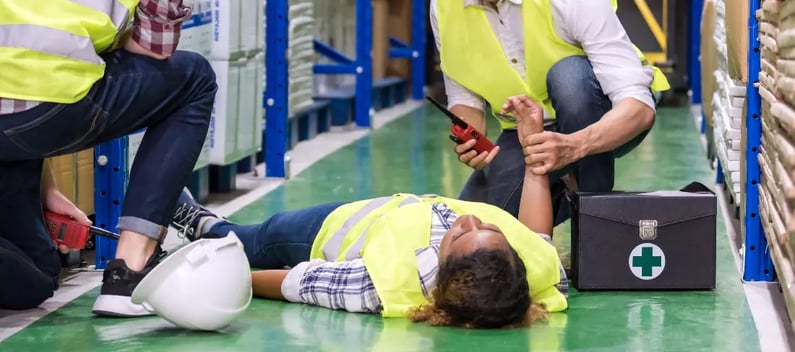
Airway
Now, check the airway is open and clear. To open the airway, place one hand on the casualty’s forehead to tilt the head back whilst using two fingers from the other hand to lift their chin.
Breathing
The next step is to check for breathing. With your ear above the casualty’s mouth, look down their body. If they are breathing, you will either be able to hear them breathing, feel their breath against your face or see their chest moving. Do this check for 10 seconds and if they are unresponsive and not breathing, call 999 or 112 immediately.
Start CPR straight away, whilst asking someone else to find a defibrillator (AED/ automated external defibrillator) and bring it to you. For more information on cardiac arrests and how to perform CPR, check out our article ‘The Chain of Survival - How to save a life with CPR & AED’.
If the casualty becomes responsive and is breathing, move on to the final step: Circulation.
|
What's the difference between a heart attack and a cardiac arrest? |
Circulation
Once the casualty is breathing, check for bleeding. If there is severe bleeding, treat it by applying pressure directly to the wound and call for emergency help on 999/112.
If the casualty is unresponsive but breathing, and there is no bleeding, put them in the recovery position and call for emergency help.
(Defibrillation)
You may prefer to remember this acronym as DR ABCD as, in the case of the casualty not breathing, CPR and defibrillation will be needed. Performing defibrillation within the first 3 minutes of sudden cardiac arrest, with an AED, can increase survival rates by over 80%.
.webp?width=795&height=353&name=Workplace%20AEDdefibrillator%20(1).webp)
Make sure that any on-site AED is easy to access and that all staff are aware of its location.
|
Automated External Defibrillation (AED) Training |
Use this cheat sheet to help remember how to carry out a primary survey:
RICE
What does RICE stand for in first aid?
When treating an injury, following the acronym RICE will help to relieve the casualty’s pain or swelling. RICE stands for Rest, Ice, Compression, and Elevation. This is particularly useful to know if you work in a school, where you might have to deal with playground incidents, or a workplace involving manual labour.
Rest
To protect the injured or sore area, the casualty should take a break from activities. Avoid exercise and other physical activity to allow for recovery. By using support, such as crutches or a walking stick, will reduce the weight being put on the injury if the casualty has suffered the injury to their knee or ankle, whilst a sling will secure the arm in the event of the injury occurring to the arm or shoulder.

Ice
Whilst they are resting, prevent or reduce swelling by applying an ice or cold pack for 15 to 20 minutes. Do this 3 or more times a day until the swelling has gone right down. Once the swelling has gone, after 48 to 72 hours, you should apply heat to the area that hurts.
Remember, don't apply ice or heat directly to the skin. Instead, you can put the cold or heat pack inside a towel, and then apply it to the skin.
Compression
Next, you can further reduce the swelling by applying pressure to the injured or sore area with an elastic compression bandage. This should not be wrapped too tightly, as that may cause more swelling.
Indicators that the bandage is too tight include: increased pain, cooling, numbness, or swelling below the bandaged area. If the problem persists for longer than 2 or 3 days, or it becomes more serious, seek advice from the doctor.
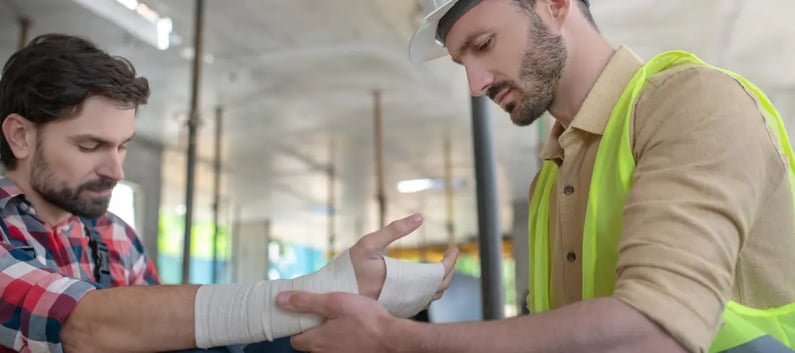
Elevation
Raise the injured area at or above heart level (you can use a pillow to support it) to minimise swelling by allowing the fluid to drain away from the affected area.
Here's a reminder of how to help someone recover from an injury or swelling using the RICE acronym:
FAST
What does FAST stand for in first aid?
If someone is having a stroke, you need to act FAST! Knowing what to do if someone near you has a stroke is crucial as it could save their life.
A stroke occurs when the blood supply to the brain is cut off, making it a life-threatening situation. You should call an ambulance on 999 immediately if you suspect that someone is having a stroke.
|
Did you know… according to Public Health England, 1 in 6 people have a stroke in their lifetime. You can identify the main symptoms of a stroke using the acronym FAST: Face, Arms, Speech, Time. |
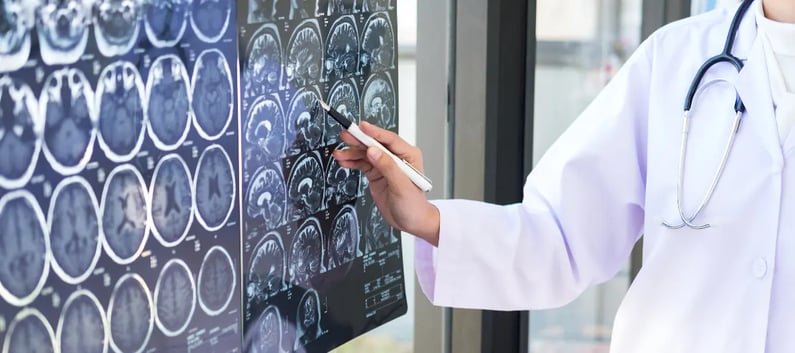
Affecting the brain, the sooner a stroke victim gets medical attention, the less damage it will likely cause.
Face
One indicator that someone is having a stroke is if their face has dropped on one side. For instance, they might not be able to smile, or you may spot that their eye or mouth has dropped.
Arms
Another stroke symptom is an inability for the person to lift both arms. Numbness or weakness may prevent them from lifting one or both of their arms.
Speech
A stroke impacts speech, too. Indicators may be slurred or garbled speech, or a complete inability to take at all, even if they appear to be awake. It may also affect their ability to understand what you're saying to them.
Time
The earlier the treatment, the likelihood of the casualty being harmed by the effects of a stroke is reduced. Therefore, if you see any of these symptoms (Face, Arms, Speech), call 999 immediately.
First Aid information for businesses
Why is First Aid important?
The Labour Force Survey found that 565,000 people sustained an injury at work in 2021/22. First aid provides casualties with immediate treatment for these injuries, hopefully with positive consequences for their physical health.
By working with first aiders, businesses can identify areas of the workplace and types of work that may pose dangers to their staff and can, therefore, put in place measures to prevent accidents from happening. HSE found slips, trips and falls on the same level to be the highest cause of non-fatal workplace injuries (30%). Good health and safety procedures help reduce dependence on first aid treatment.
How many first aiders are required in a workplace?
The number of first aiders required in a workplace is risk-related. For a low risk workplace, where the risk of serious injury or illness is low, HSE Guidance requires 1 first aider for every 50 workers. Meanwhile, a high risk workplace, where people are working with heavy equipment or dangerous machinery, requires 1 first aider for every 25 workers.
How long does a first aid certificate last?
First aid certificates last for 3 years, including First Aid at Work (FAW) and Emergency First Aid at Work (EFAW). First aiders are strongly recommended by HSE to take a First Aid Annual Refresher course once every year to update their first aid skills.

We offer a variety of online courses, including first aid training, with quick and easy onboarding for you and all your staff. Take a look at our training packages to discover how you can provide a safer and healthier workplace and beyond.
The acronyms in this article provide vital information that can save lives. Sharing this with colleagues, family or friends will help spread awareness and build the confidence and knowledge to perform first aid in the event of a medical emergency.

-1.webp?width=243&height=74&name=Logo%20R%20Homepage%20White%20Final%20Horizontal%20Large%20NEW%20small%20(2)-1.webp)
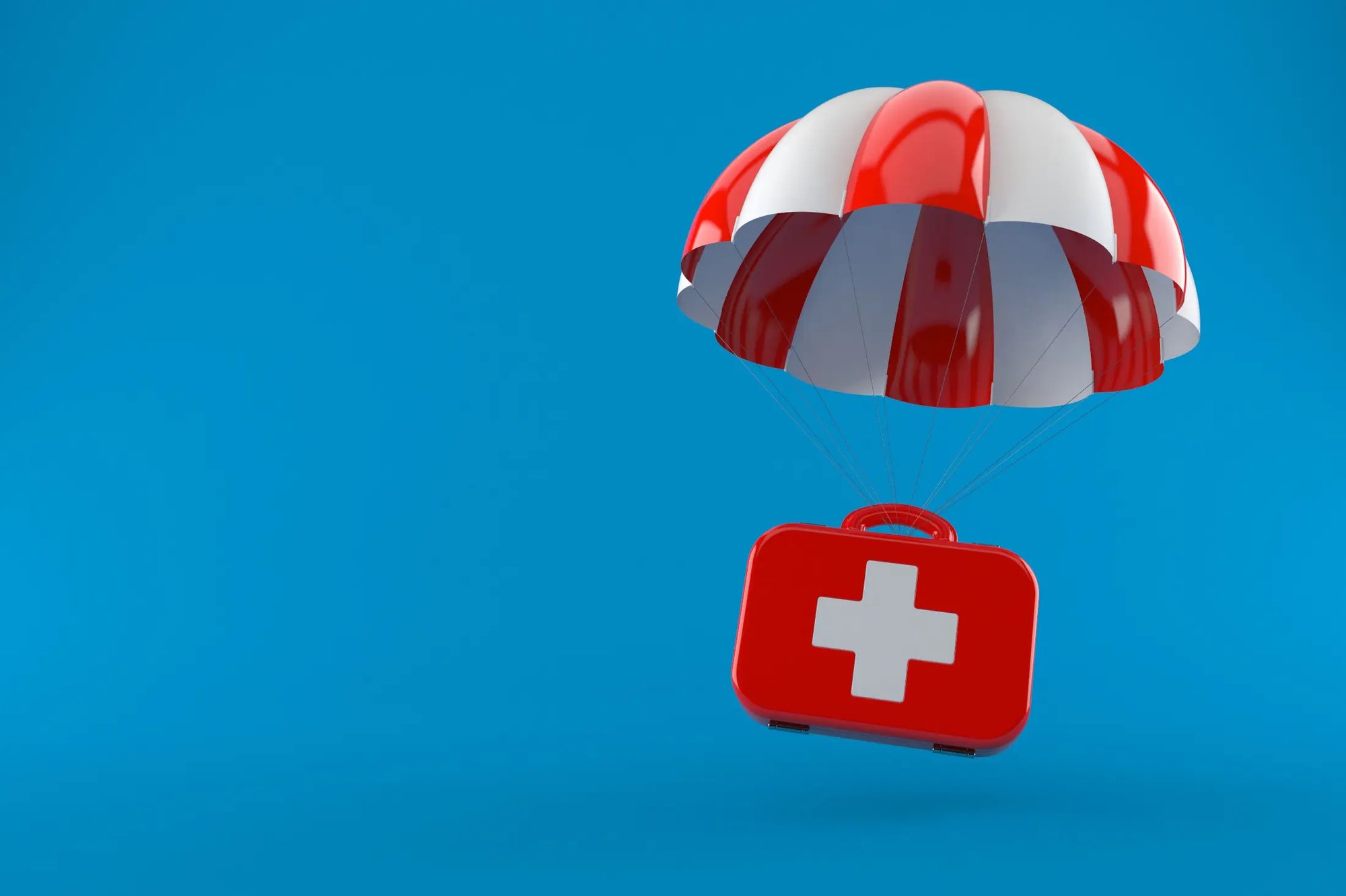
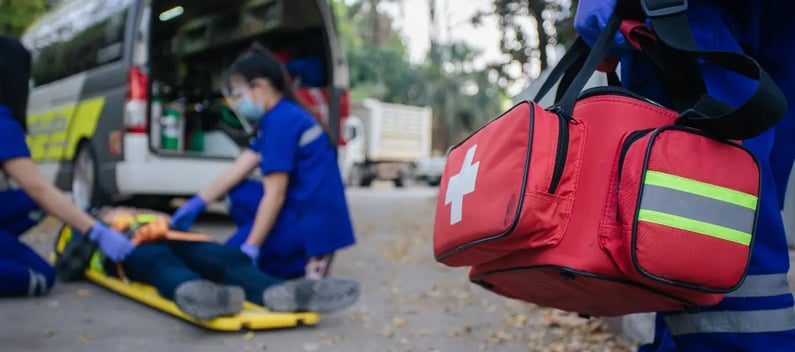
.webp?width=795&height=353&name=DR%20ABCD%20acronym%20for%20emergency%20first%20responder%20(2).webp)
.webp?width=795&height=353&name=RICE%20acronym%20for%20treating%20an%20injury%20(1).webp)
.webp?width=795&height=353&name=Act%20FAST%20if%20someone%20has%20a%20stroke%20(1).webp)
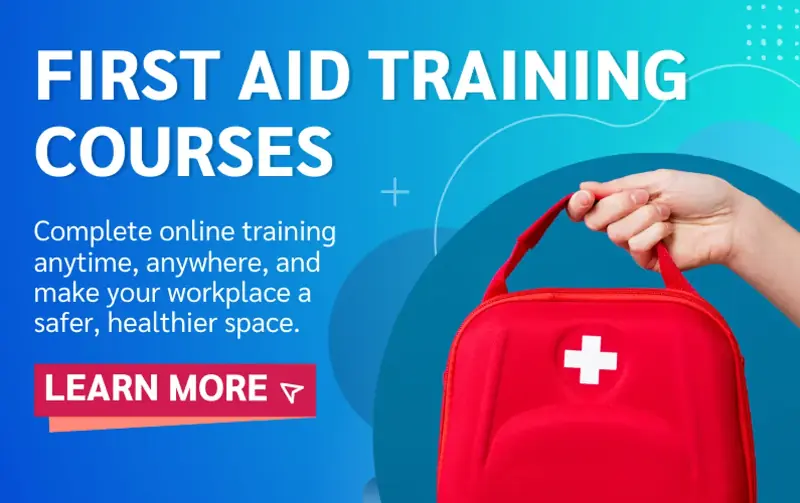

-1.webp?width=50&height=59&name=Cyber%20Essentials%20Badge%20Large%20NEW%20(72dpi)-1.webp)
COMMENTS